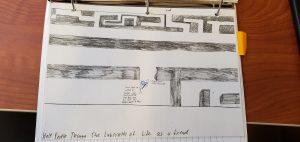Hello everyone, I know that this isn’t what we usually do with our blogs–this is more personal. Let me introduce myself. My name is Mitchell Carpenter, I am a second year here at Michigan Tech, and I have been working in the Office of Continuous Improvement for about a year now. One of my co-workers, Rylie Kostreva, recently wrote a blog about how she was going through a coaching process. Since then she has begun to take me through the process as well. Explaining to someone about the process of being “coached on how to coach” can be a bit confusing, so try not to get lost!
My journey through this process began with Rylie asking me a simple question: “Hey, do you want to be coached on how to coach?” At first I wasn’t too sure what she meant, but from what she was telling me about her own journey it sounded interesting. I agreed, and we scheduled a launch meeting. The launch meeting was interesting; she handed me a stack of papers, and we went through what our normal meetings would look like and how I would have some homework to do before each meeting with a reflection to write after. I didn’t know why I was doing any of it; it was just something to do. It very quickly evolved into something that I enjoyed doing; it got personal and helped reveal some things that I didn’t even know about myself.
One of the major things that Rylie had me do was create a leadership statement–a statement that describes who I want to be as a leader and how I want to coach people. I started the process by asking people who are important in my life the question of who I am to them. This helped me better distinguish between what I am doing already and what I want to do in the future. My statement was, “Help people through the labyrinth of life as a friend.” Rylie pointed out that I could have ended it after the word “life” but I didn’t, and that last bit is what made the statement mine. The next task was to make an illustration to go along with my statement. When I did, it didn’t feel complete. Rylie suggested that I do a card activity where I laid out a bunch of pictures and narrowed it down to 5-7 cards. After doing so, a trend emerged, a trend of loneliness and calm. After analyzing this I was able to come up with an illustration that fully captured my statement.
My illustration shows two people, myself being represented as the one in back. This describes my statement because I see myself as being a leader behind the person I’m leading. My focus is to let people lead their own lives, but I’ll help guide them through it, be there for them when they need me, and give them space when they need it. That is who I want to be, a friend first and a coach second.
Rylie then suggested that I go deeper with my analysis of the pictures, so I did. I found that to me loneliness isn’t always bad, it can be needed, but it can also be terrible. It’s something I have experienced a lot in my life and have been afraid of at times. Calm also has a significant role in my life, especially in today’s world it is important to be calm in order to be the voice of reason. Both of these things are important for me to help lead as a friend. I want to keep people from feeling lonely and being afraid of being lonely. As a friend I can help people remain calm in times of distress and make the right decision for them.
My next step is to meet with different people in order to get an outside perspective on my coaching process and possibly have them reveal different aspects of it that I didn’t see. I am looking forward to this next step and can’t wait to see where coaching leads me. This journey has meant a lot to me personally and I am very grateful to Rylie for asking me if I wanted to go through it with her.

Mitchell, I enjoyed your reflection on the coaching and getting coached process. You seem to be fairly comfortable with the interactions and activities. Your statement and picture are very well-considered and I can tell they are meaningful to you. Enjoy the journey!